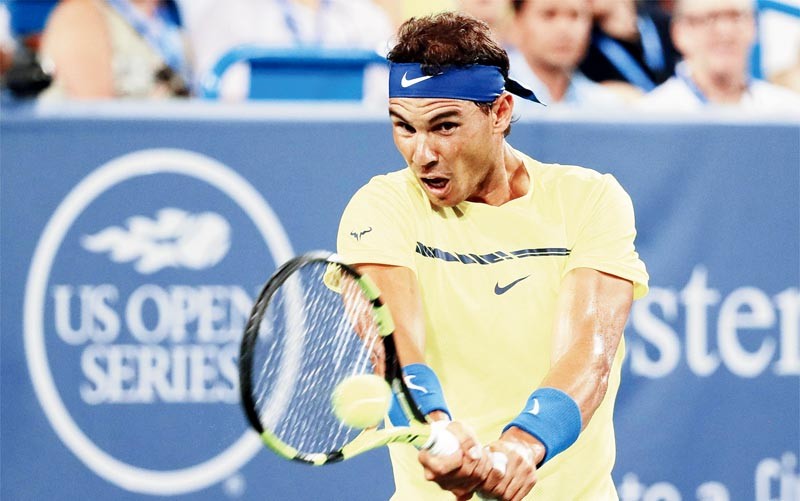
The start of the year was almost a different tennis universe, where neither Federer nor Nadal was expected to win any more majors. Now they are a Nadal win away from evenly splitting the four Grand Slam titles of the year, and truly making it the year of ‘Fedal’

It is safe to say ‘beast mode’ Rafa was on following the first set against Argentina’s Juan Martin Del Potro in the second semifinal, perhaps for the first time outside of clay since the 2013 North American hard court swing. After losing the first set 6-4, Nadal stampeded all over his opponent, to set up the final against Kevin Anderson tonight (1.00am PST).
28th seed Anderson, at 6ft 8 inches the tallest ever major final, emerged out of the bottom half, which even at the time of the draw was the conspicuously weaker section.
With Andy Murray withdrawing two days before the tournament started, Alexander Zverev - fancied by many as the winner this fortnight - being toppled in the second round, and 2014 US Open Champion and this year’s Wimbledon finalist Marin Cilic going out in the third, the bottom half was guaranteed a first time major finalist as early as the Round of 16.
Anderson seized the opportunity, eventually reaching the final after beating Pablo Carreno Busta 4-6, 7-5, 6-3, 6-4 in the first semifinal. In the quarters, the South African had overcome the home favourite Sam Querrey - who himself has had a highlight year - in a tight four-setter.
Anderson, whose previous best showing at a major was the 2015 quarterfinal in the US Open, and has never made it past the fourth round at any of the Grand Slam events, will now take on World No 1 Rafael Nadal, who is seeking his 16th major and a third crown at Flushing Meadows.
Nadal hasn’t won a major outside of Roland Garros since US Open 2013, losing the Australian Open finals in 2014 and earlier this year. And the Spaniard would be the overwhelming favourite for tonight’s final.
Nadal has played all three of his previous US Open finals against Novak Djokovic - easily the best hard court player of the past decade - winning in 2010 and 2013, and losing the 2011 final. Anderson would pose a different challenge, as the clear underdog.
Nadal eventually won his semifinal 4-6, 6-0, 6-3, 6-2, and it could even have been a complete landslide in the third and fourth sets as well, with Del Potro facing a barrage of break points even in the games that he held on serve.
Rafa is accustomed to hitting less winners than his opponents, even when he’s winning and playing an aggressive brand of tennis. So the fact that he had almost twice the number of winners (45 to 23) as Del Potro - who had overpowered Roger Federer and Dominic Thiem in the previous two rounds, and has one of the most bulldozing repertoire of ground strokes in the game - shows what a dominant performance it was by the Spaniard against the man who completely destroyed him at the same stage of the same major in 2009.
On paper, Anderson has the game to trouble Nadal. He is a tall, big-hitter with a massive serve and powerful ground strokes from both wings - the prototype of the kind of player that troubles the Spaniard’s game.
However, it might be a lot for Anderson to produce his absolute best against Nadal in his first major final having never made even an ATP 1000 semifinal.
Even so, being the outsider could also work in the South African’s favour. If he can distance himself from the inevitable nerves early into the match, the fact that there would be no pressure on him at all can help him do well. But Nadal has been in similar situations many times before, and would know exactly how to approach the final.
There would be a different kind of pressure on Nadal than he has at the French Open, where he has set the bar to a point where he is expected to win tournament after tournament and match after match, which is pretty much what he has been doing for over a decade, culminating in La Decima in June this year. But now the pressure is to finally win a Grand Slam title outside of his beloved clay for the first time in four years.
What is also up for grabs is the year-end number one ranking. Even though it would be far from settled, winning the US Open final would put Nadal in firm control at 9,465 points, almost 2,000 more than second-placed Federer, with two ATP 1,000 events and the World Tour Finals still to come this season.
Winning the 16th major would also put Nadal two clear of Pete Sampras at second place, and bring the gap from Federer at the top down to three Grand Slam titles, which is the same as it was when the year began.
However, the start of the year was almost a different tennis universe, where neither Federer nor Nadal was expected to win any more majors. Now they are a Nadal win away from evenly splitting the four Grand Slam titles of the year, and truly making it the year of Fedal.
But it is evident that the Grand Slam tally and even the number 1 ranking is not something Nadal concerns himself too much with. For him it has always been about winning the next match, the next title.
Winning his next match would give him the title that would reaffirm his return to the absolute pinnacle of men’s tennis, and give everyone the reminder that he’s not going anywhere anytime soon.